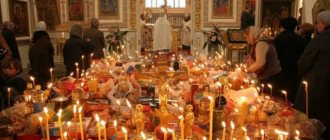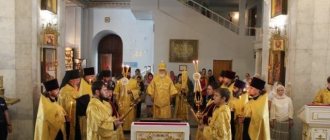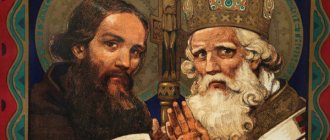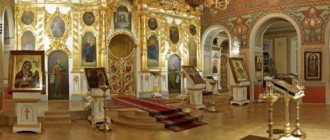Catechumens (Greek “κατηχούμενοι”, Latin “cathechumeni”) or catechumens, sometimes “hearers” (“ἀκροαταί”, “audientes”) are followers of Christ who have not yet accepted Baptism, but are preparing for it. The Greek word "catechumens" is a participle of the verb "κατηχέω", meaning "to announce", that is, to sound out loud, or "to communicate to a wide audience." In Christianity, this term gradually acquired the meaning of “to instruct in the truths of faith.”
Formation of the institution of catechumens in the Ancient Church
Despite the fact that the catechumen in the broad sense is sometimes spoken of as a phenomenon associated with the preaching of the apostles and the Lord Jesus Christ himself, the institution of the catechumens in the classical, narrow sense, that is, as a special order of instruction in the faith for its conscious confession upon entry into the Church , spread in the ancient Church only from the beginning of the 3rd century.
However, even before this time there are references to preparation for the Sacrament of Baptism through fasting, prayer and moral instructions. Thus, the first part of the Didache (Didache 1–6), containing moral teaching, is prescribed by the author of this ancient monument of Christian literature to be taught to the baptized (Didache 7). The Holy Martyr Justin Philosopher, who suffered in Rome in 165 or 167, in his “First Apology” (1 Apol. 61) reports on the pre-baptismal fast and prayer of both those preparing to receive the sacrament and the Christians who sympathize with them. Tertullian, whose active period of creativity occurred at the turn of the 2nd and 3rd centuries, first mentions the word “cathechumeni” and considers fasting, prayer, vigilance and kneeling necessary for the catechumens (On Baptism 20).
Catechumens in the 3rd century. according to the Apostolic Tradition
A detailed description of the catechumen is contained in the “Apostolic Tradition,” the author of which was long considered to be St. Hippolytus of Rome. This text shows church life in the 3rd century, but may contain additions made a century later. According to the “Apostolic Tradition” (Apostolic Tradition. 15–22), those who wished to become a Christian were brought together with a successor who testified to his readiness to listen to the teachers. The latter asked questions about the reason for turning to faith, marital status, social status, and lifestyle. For a slave owned by a Christian, the additional testimony of a master was required. Also, “Apostolic Tradition” provides a whole list of professions that prevented inclusion in the number of catechumens. In addition to those obviously impossible for a Christian, such as a brothel owner, a harlot, a pagan priest, a maker and guardian of idols, they included an actor, a gladiator, and a horseman participating in competitions. Even the intention to become a warrior was prohibited; teaching children was allowed only as an exception. A slave-concubine could be included in the number of catechumens, but the master who had a concubine had to “take a wife according to the law.”
The period of the catechumen lasted three years, however, in the case of the virtuous life of the catechumen, “not the time, but the behavior itself was taken into account.” Protoprev. Nikolai Afanasyev notes that this could also mean a reduction in the period due to illness and an increase in it, for example, for former priests.
Each teaching of the catechumens ended with a prayer, where the catechumens prayed separately from the faithful, men separately from women. The prayer of the catechumens, unlike the prayer of the faithful, did not end with the “kiss of peace.” After the prayer, the teacher, who could also be a layman, laid hands on the catechumens. A Christian who became a martyr during the period of his catechumen, as specifically stated in the “Apostolic Tradition,” “received Baptism with his own blood.”
In the event that the catechumen led a virtuous life, upon completion of the time of catechesis and the recipient’s guarantee of his dignity, he could be allowed to hear the Gospel at the service and become one of the “elect.” “Hands were laid on such catechumens who had passed into a new quality every day while they were being conjured.” As the day of Epiphany approached, the bishop again experienced the dignity and purity of the catechumen. If the decision was positive, the catechumens were ordered to wash themselves on the fifth day of the week, fast on the eve of Saturday, and on Saturday itself to gather and receive a spell from the bishop, who then proceeded directly to the rite of Baptism.
Work on mistakes
The second of the obligatory public conversations is devoted to how the Sacrament of Baptism will take place. It is conducted by the cleric of the temple, priest Andrei Solodko. Those who come to the second conversation had to do their “homework”: read at least one of the Gospels and prepare for confession and Communion. Father Andrei asks: “Did you manage?” It turns out that no one read the Gospel. Two people are ready for confession and Communion. The rest referred to being busy. This shouldn't be surprising. Even parishioners with many years of church experience sometimes find it difficult to overcome their own spiritual relaxation and lukewarmness. What can we say about those who come to the temple from time to time! It would not be an exaggeration to say that confession and Communion are a feat for them.
And yet it is clear that the previous conversation with Father Kirill was not in vain for them. Now, when asked who Jesus Christ is, they answer more confidently: perfect God and perfect Man. Of course, to say that these conversations completely revealed the world of the Orthodox faith for them would be self-deception. The best result that can be counted on is that for the first time these people will think about what it means to be a believer, that God is serious, and the temple is not a store that sells our national amulets.
Catechumens in the 4th–5th centuries.
By the Edict of Milan in 313, Christianity was recognized as a permitted religion in the Roman Empire. In addition, it received the patronage of St. equal to Emperor Constantine the Great and all his successors with the exception of Julian the Apostate. Already in 380, Emperor Theodosius the Great, by edict Cunctos populus, recognized the Nicene faith, that is, proclaimed by the First Ecumenical Council, as mandatory for all subjects of the Empire.
The announcement thus continued to develop under completely new conditions. The two stages of the catechumen, which were spoken of by the Apostolic Tradition, have been preserved, but have undergone some changes. Due to the fact that becoming a Christian was no longer dangerous, but often provided additional benefits, the number of people wishing to become catechumens increased. Often the opportunity to question those who came in detail was lost. They could be admitted to the category of catechumens without additional testing through making the sign of the cross, laying on of hands and incantation. They could attend divine services, with the exception of the Eucharist itself (“liturgy of the faithful”), read Scripture, listen to sermons, which replaced special classes.
It became commonplace to prolong one's stay in the rank of catechumens. This could be due to the fact that the same moral requirements were not applied to the catechumens as to the faithful, or because of established custom. Thus, we know about the Baptism by adults of the Church Fathers who came from Christian families: the Great Cappadocians, St. John Chrysostom, Blessed. Augustine of Ippona. All of them, however, eventually became preachers of early Epiphany.
Those who wished to receive Baptism as soon as possible reported their names to the bishop for recording and only then proceeded directly to preparation, which ended with the celebration of the sacrament on one of the main holidays: Easter, Pentecost, Epiphany (depending on local custom). Such catechumens were called “enlightened” (“φωτιζομένοι”, “illuminandi”) or “elected” (“electi”).
A description of such a practice is contained in the famous “Pilgrimage” of Egeria, travel notes of a Western pilgrim made on a trip to the East. The pilgrimage took place in the second half of the 4th century. and its record reflects the catechetical practice of Jerusalem. The author reports (Pilgrimage, 45) that the name should have been recorded among those baptized before the beginning of Lent. This was done by the presbyter, and the bishop, at the beginning of Lent, in the presence of the clergy, one by one received everyone on the lists along with their recipients and asked friends about them. If they had a good testimony, they were included in the “elect.” Then, during the forty days of Lent, after the morning service, the catechumens preparing for Baptism were conjured by the presbyters, and after this the bishop began his teaching for them. Only the faithful and catechumens, who intended to receive Baptism at the coming Easter, could listen to him. The bishop gradually expounded the Scriptures “from Genesis” and interpreted them. After five weeks, the catechumens “received” (listened to) the symbol, and the bishop explained it. Each session lasted for three hours, from the first to the third hour. In the last week of Pentecost, the catechumens again came to the bishop one by one, “the husband with his father, the wife with her mother,” that is, with their guardians, and “returned” (i.e., read) the symbol to the bishop, after which he reported that after Baptism, the “hidden mysteries of God” will also be explained to the newly enlightened.
The content of the Jerusalem Catechumen is shown by the “Catechetical Teachings” of St. Cyril of Jerusalem. The catechetical conversations of St. have also been preserved. John Chrysostom and Theodore of Mopsuestia, containing information about the immediate preparation for Baptism in Antioch. Here it lasted thirty days, and the catechumens had greater access to knowledge about the sacraments. The announcement in the West is reported in the works of the blj. Augustine and St. Ambrose of Milan. Here, less attention was paid to the interpretation of the symbol, and there was also no “private” reading of it before the bishop by each of those being baptized.
By the end of the 5th century. The institution of catechumens begins to decline. This is due to the fact that the majority of those baptized are beginning to be infants, children of Christian parents. Despite this, in the Typikon of the Great Church, that is, the liturgical charter of the Church of Hagia Sophia in Constantinople (10th century), the catechumenate is still associated with Great Lent. And although the “catechumens” were mostly children three years old, the main rites of catechumen were still performed on them.
Traces of the catechumen have been preserved in modern worship. Thus, at the Liturgy of the Presanctified Gifts, from the middle of Great Lent, a special litany is pronounced about “those who are preparing for enlightenment.” Prayers for the catechumens are present in the rite of the Divine Liturgy, and finally, the Breviary contains “the prayer to create the catechumen,” exorcisms, the rite of renunciation of Satan and the combination of Christ, as well as the reading of the Creed, which recalls its “return” in the Ancient Church. This rite is usually performed immediately before the sacrament of Baptism.
Orthodox Life
Answered by priest Andrei Chizhenko.
So, who are the catechumens? In Greek they are called “katikhumeni”, i.e. people who wish to be baptized and undergo a catechumenate for this, a preliminary oral instruction (catechumen) in the Orthodox faith. These are the people who learn the basics of Orthodoxy, learn how to glorify God correctly.
In ancient times, during the first centuries of Christianity, it was practically impossible for an adult to be baptized (unless in view of mortal danger to life) without going through a catechumen, that is, without receiving instruction in the Orthodox faith.
The announcement could last three years or longer. In the process of this training, a person was immersed in Orthodoxy. He began to understand what a great shrine was opening up for him! Sacrament of Baptism.
When a person in ancient times wanted to be baptized, then he turned either to a believing layman or to a clergyman directly. The priest blessed him to pass the announcement. Special teachers were assigned to him, who were supposed to instruct him in the basics of Orthodoxy. And only when this teacher believed that the catechumen was ripe for the Sacrament of Baptism, then he gave his recommendation, and the person began to prepare for the Sacrament of Baptism.
In ancient times, people were baptized, as a rule, on great holidays, for example, on Holy Saturday, so that a person could celebrate the Bright Resurrection of Christ and partake of the Body and Blood of Christ at the Easter Liturgy. They also baptized on the feast of the Epiphany (Epiphany of the Lord) and on other twelve feasts.
This is where the tradition of having successors came from. Initially, he became a teacher who instructs the catechumen in the basics of Orthodoxy. He had to lead man to God.
We must understand that the Sacrament of Baptism is not just a beautiful rite. The Sacrament of Baptism is the door to the Church, a great shrine that a person receives into himself. In the Sacrament of Baptism, the Lord bestows His grace-filled Gifts on a Christian so that he can draw closer to Him, develop his soul, ascending from measure to measure along the ladder of spiritual perfection, uniting with God. And for these gifts, a person in due time will answer before the Lord: whether he buried them in the ground, neglected them, or multiplied them, making a blissful ascent to his Creator and receiving the greatest joy of salvation, deification in union with Him.
This is what the recipient should teach his child. That's why it's needed. We should always understand that the Sacrament of Baptism opens before a person the door to the Church, which is the road to Heaven. And it is important not to be baptized and forget this road, not to leave it, but to stand firmly on it and walk along it step by step, developing in our native Orthodoxy. It should become native to a person, it should become life itself. Because God is the Source and Giver of life. Without Him there is no life.
And, as we said above, the recipient must teach a person to love God, go to Him and unite with Him. The recipient and his child, who together began this great journey to paradise, to the Kingdom of Heaven, will receive and are already receiving saving grace-filled gifts from God.
But do they really want to go to God, do they crave communion with God more than anything else, seeing in it the main treasure of their life?
Today we often see a slightly different picture. Godfathers (godfathers) are taken because they are a friend, or a good person, or they expect material preferences from him. Sometimes the recipient himself needs to go through the catechumen, and not be a spiritual teacher. These are, of course, the consequences of the secular culture of the Soviet period. Today we are also struggling with an agnostic perception of the world and religious omnivorousness. All these atheistic, heretical, or pagan, esoteric, or generally consumerist, utilitarian attitudes towards the Sacrament of Baptism are very dangerous. A person often does not answer the main question: why am I going to be baptized, or become a godparent, or baptize a child?
Man does not answer the question: do I need God? And if you need it, then how to go to Him? How to communicate with Him?
The worst thing for a priest who performs the Sacrament of Baptism is an absent look and secretly glancing at his watch: they say that he is crucifying himself here in front of us, the restaurant has already been ordered and the kebab is getting cold. Yes, you can still not completely immerse the child, but only wet his hands and feet. And don’t pour too much on the head either, so as not to catch a cold.
It hurts, it all hurts a lot. And the priest is crucified here, trying to open Heaven to people with God’s help, to snatch them from the vale of the earth, from this swampy, sucking whirlpool.
And when the Sacrament of Baptism has been performed, you look at the joyful recipients, grandparents, parents and think: “Now they will leave the temple, and when will they enter it next time? And will they even come in?”
Today this baptized person has become a consecrated icon of God, a temple, a vessel of the grace of the Holy Spirit. What will he do with this gift? Maybe he’ll bury his sins in a garbage heap and never remember him. And at the Last Judgment, the Sacrament of Baptism will serve him as a grave condemnation. I buried my talent in the ground, in the dirt.
But perhaps the image of God in him, through the grace of the Holy Spirit and the efforts of the person himself and his successors, will shine in him, sparkle with holiness. From strength to strength, from measure to measure, man will ascend to God along the ladder of spiritual perfection.
We are priests. We were sent by Christ to sow, as He sowed, and He is still sowing through us. Sprout, our dears, germinate in Orthodoxy and bear fruit! This is very important for yourself. This is the most significant thing in the world.











